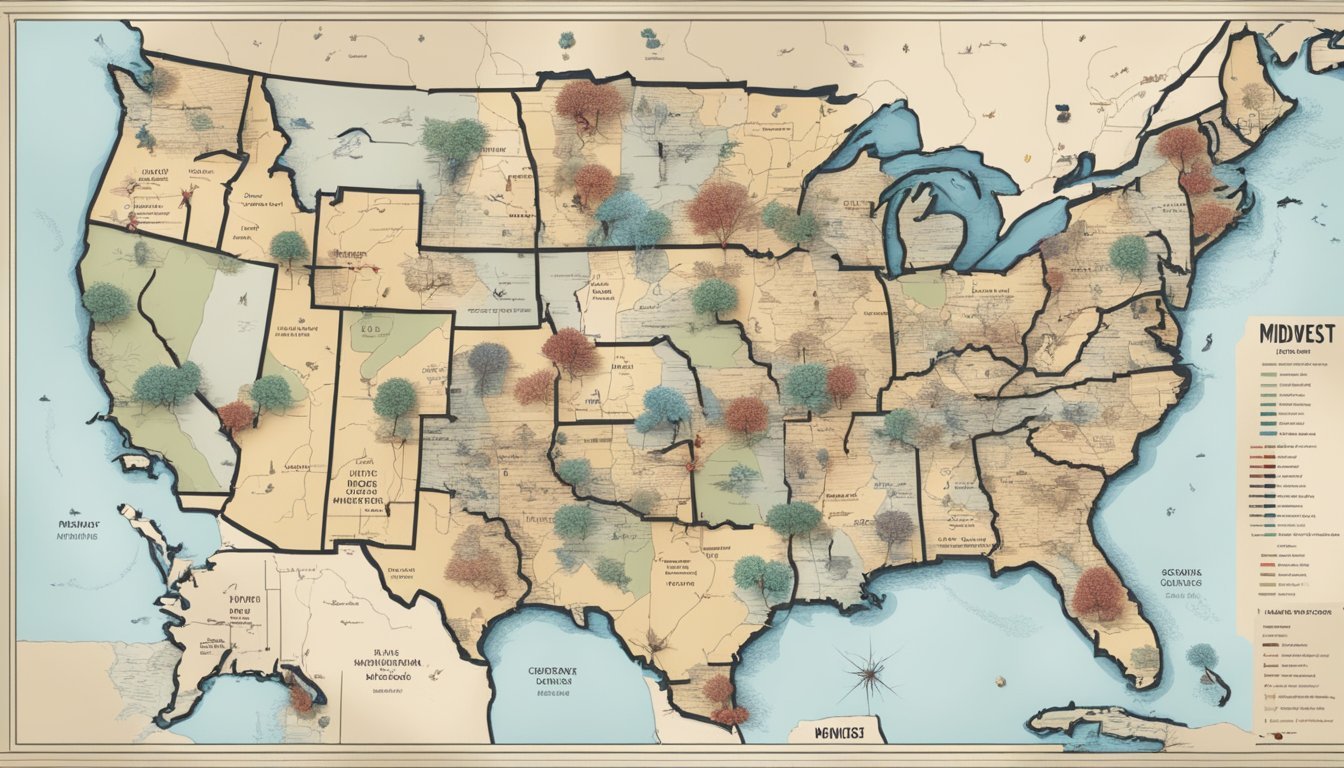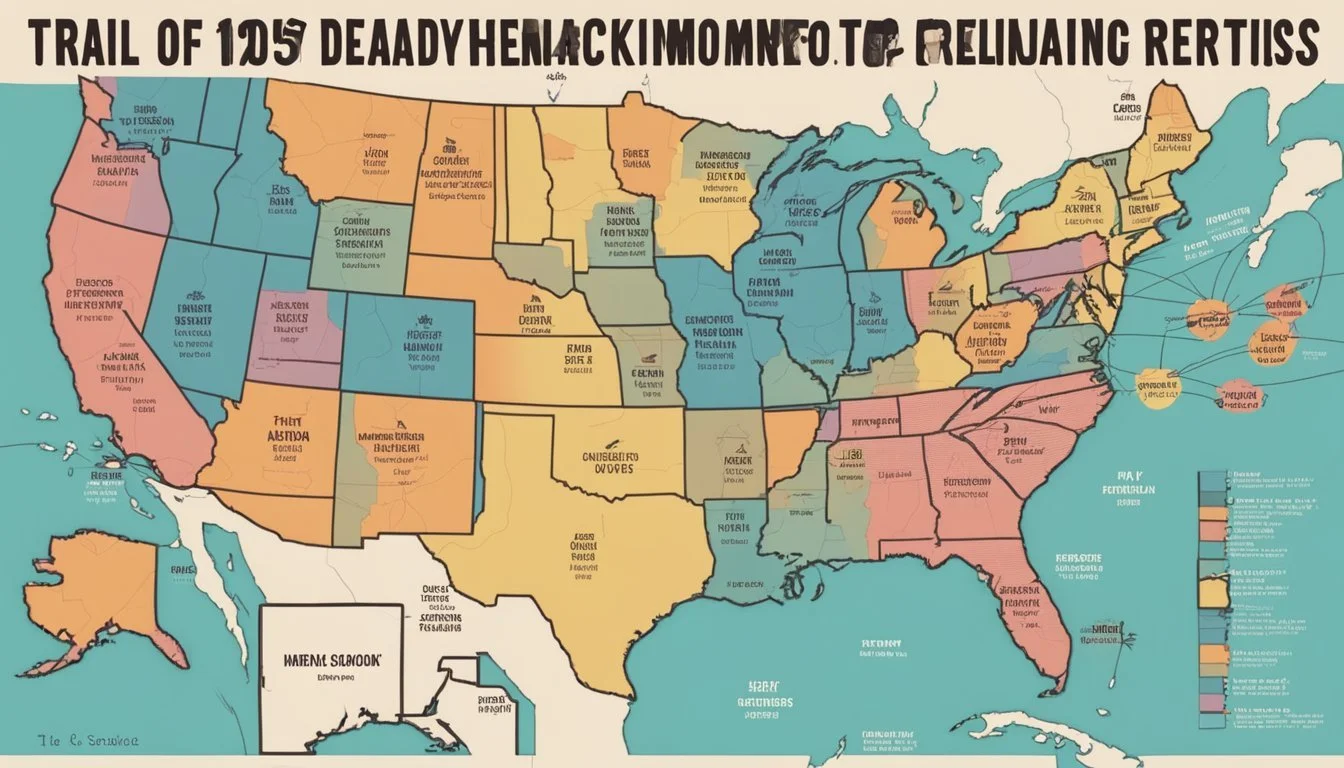Alton Coleman: 9 States Terrorized by the Midwest's Deadly Duo
A Cross-Country Crime Spree
In the summer of 1984, a crime spree gripped the American Midwest with fear and sparked one of the largest manhunts in U.S. history. The perpetrators, Alton Coleman and Debra Brown, left a trail of violence across multiple states, committing murders, rapes, kidnappings, and armed robberies.
Law enforcement agencies from Illinois, Wisconsin, Michigan, Indiana, Ohio, and Kentucky coordinated efforts to track down the deadly duo. Their 53-day rampage captivated public attention and tested the resources of police departments across the region. The case of Coleman and Brown stands out as a chilling example of a killer couple whose actions terrorized communities and left a lasting impact on the criminal justice system.
1) Crime Spree Across the Midwest
Alton Coleman and Debra Brown embarked on a harrowing crime spree across the Midwest in the summer of 1984. Their 53-day rampage spanned six states, leaving a trail of violence and terror in its wake.
The duo's crimes included eight murders, seven rapes, three kidnappings, and 14 armed robberies. Their actions sparked one of the largest manhunts in U.S. history, involving law enforcement agencies from Illinois, Wisconsin, Michigan, Indiana, Ohio, and Kentucky.
Coleman, 28, and Brown, 21, targeted victims indiscriminately as they traveled through the region. Their brutal acts shocked communities and instilled fear in residents across the Midwest.
The couple's crime spree began in May 1984 and continued until their capture in July of the same year. During this period, they moved frequently to evade authorities, making it challenging for law enforcement to track their movements.
Their actions drew national attention and highlighted the need for improved interstate cooperation among law enforcement agencies. The case remains one of the most notorious crime sprees in American history.
2) Gruesome Details of the Attacks
Alton Coleman and Debra Brown's crime spree was marked by extreme brutality. They targeted victims of all ages, including children and the elderly.
The couple often used everyday items as weapons. In one case, they strangled a victim with an electric cord. Another was beaten with a tree branch.
Sexual violence was a frequent component of their attacks. Multiple victims suffered sexual assaults before being murdered.
Coleman and Brown sometimes kept victims captive for extended periods. This allowed them to inflict prolonged physical and psychological torture.
The pair frequently stole their victims' belongings and vehicles. This helped them evade capture as they moved between states.
Their methods of killing varied. Some victims were strangled, others beaten to death, and some were shot.
The duo showed little remorse for their actions. They often seemed to derive pleasure from the suffering they inflicted on their victims.
3) The Deadly Duo's First Victims
Alton Coleman and Debra Brown's murderous rampage began in May 1984 with the disappearance of Vernita Wheat, a 9-year-old girl from Kenosha, Wisconsin. Coleman had befriended Vernita's mother and gained her trust before abducting the child.
Vernita's body was discovered on June 19 in Waukegan, Illinois. She had been sexually assaulted and strangled. This horrific act marked the start of Coleman and Brown's violent crime spree across the Midwest.
The deadly duo's next victim was Tamika Turks, a 7-year-old girl from Gary, Indiana. On June 18, Coleman and Brown lured Tamika and her 9-year-old aunt into a wooded area. They sexually assaulted both children and strangled Tamika to death.
Tamika's aunt survived the attack, providing authorities with crucial information about the perpetrators. This survivor's account helped law enforcement identify Coleman and Brown as the suspects in these brutal crimes.
These initial murders set the stage for the couple's subsequent acts of violence, which would span multiple states and leave a trail of devastation in their wake.
4) Police Investigations and Breakthroughs
Law enforcement agencies across multiple states coordinated efforts to track down Alton Coleman and Debra Brown during their 1984 crime spree. The manhunt became one of the largest in U.S. history, involving authorities from Illinois, Wisconsin, Michigan, Indiana, Ohio, and Kentucky.
Police faced challenges in capturing the duo due to their frequent movement across state lines. Investigators worked to connect the crimes and establish a pattern, relying on witness descriptions and forensic evidence.
A breakthrough came when authorities identified Coleman and Brown as the prime suspects. Their photos were widely circulated, leading to increased public awareness and numerous tips.
The search intensified in July 1984 as more victims were discovered. Police departments shared information and resources, creating a unified front against the dangerous pair.
On July 20, 1984, the manhunt culminated in Evanston, Illinois. Alert officers spotted Coleman and Brown at a park, leading to their arrest. This breakthrough ended their 53-day reign of terror across the Midwest.
5) Public Reactions to the Crimes
The Midwest was gripped by fear during Alton Coleman and Debra Brown's 1984 crime spree. Communities across multiple states were on high alert as news of their violent acts spread.
Law enforcement agencies received numerous tips from concerned citizens. Many people reported sightings of the duo, leading to an increased police presence in various areas.
Local media outlets provided constant updates on the manhunt, keeping the public informed. This heightened awareness caused some residents to alter their daily routines and take extra precautions.
Neighborhood watch groups formed in some communities, with residents looking out for one another. Some businesses reported decreased foot traffic as people became wary of venturing out.
The crimes also sparked discussions about safety and security measures. Schools and community centers held meetings to address concerns and provide safety tips to residents.
Relief swept through affected states when Coleman and Brown were finally apprehended. Many citizens expressed gratitude to law enforcement for their efforts in capturing the duo.
6) Courtroom Dramas and Sentencing
Alton Coleman and Debra Brown faced multiple trials across several states for their crimes. The legal proceedings were complex due to the interstate nature of their spree.
In Ohio, Coleman was convicted of the murders of Marlene Walters and Tonnie Storey. He received death sentences for both crimes. Brown was also convicted and sentenced to death for the Walters murder.
Indiana courts found Coleman guilty of killing Tamika Turks and sentenced him to death. Brown received a 60-year prison term for her role in the Turks case.
Illinois tried Coleman for the murder of Vernita Wheat, resulting in another death sentence. The couple faced additional charges in other states, but these trials were deemed unnecessary due to existing death sentences.
Throughout the trials, Coleman often acted as his own attorney, creating dramatic courtroom scenes. His behavior ranged from outbursts to attempts at charming the jury.
Appeals processes dragged on for years, with Coleman's lawyers arguing various points, including claims of mental incompetence. Despite these efforts, Coleman's executions were ultimately carried out.
7) Psychological Profile of Alton Coleman
Alton Coleman exhibited traits consistent with antisocial personality disorder and psychopathy. His behavior demonstrated a lack of empathy, disregard for social norms, and impulsivity.
Coleman's troubled childhood likely contributed to his psychological issues. Abandoned by his mother at birth, he experienced neglect and instability during his formative years.
As an adult, Coleman displayed manipulative tendencies and charm, enabling him to gain victims' trust. This superficial charisma masked his underlying violent impulses and lack of remorse.
His crimes revealed a sadistic streak, as he derived pleasure from inflicting pain and exerting control over others. Coleman's actions showed an escalating pattern of violence and sexual deviance.
The partnership with Debra Brown intensified Coleman's criminal behavior. Their dysfunctional relationship created a feedback loop of encouragement for increasingly brutal acts.
Coleman's ability to evade capture for an extended period suggests a level of cunning and adaptability. However, his impulsiveness ultimately led to mistakes that allowed law enforcement to apprehend him.
8) Impact on the Families Involved
The murders committed by Alton Coleman and Debra Brown left a trail of devastation for the victims' families. Parents, siblings, and extended family members were suddenly thrust into unimaginable grief and loss.
Many families struggled to cope with the brutal nature of the crimes. The seemingly random selection of victims added to their sense of helplessness and fear.
The extended manhunt kept families in a state of anxiety, unsure if the killers would strike again. Some reported difficulty sleeping or going about their daily routines during this period.
For those whose loved ones were kidnapped, the agonizing wait for news took an enormous emotional toll. When bodies were discovered, families faced the traumatic process of identification and burial.
The high-profile nature of the case meant many families had to deal with intense media scrutiny during their time of mourning. This added stress to an already painful situation.
In the aftermath, some family members became advocates for victims' rights or worked to keep their loved ones' memories alive through charitable foundations.
9) Legacy of Fear in the Midwest
Alton Coleman and Debra Brown's crime spree left an indelible mark on the Midwest. Their 53-day rampage across multiple states in 1984 instilled a pervasive sense of fear and vulnerability in communities throughout the region.
The widespread nature of their crimes, spanning Illinois, Wisconsin, Michigan, Indiana, Ohio, and Kentucky, amplified the anxiety felt by residents. Many people became wary of strangers and more cautious in their daily lives.
The case highlighted the need for improved communication and coordination between law enforcement agencies across state lines. It led to enhancements in interstate cooperation and information sharing among police departments.
Coleman and Brown's crimes also brought attention to gaps in the criminal justice system. Questions arose about how Coleman, with his prior record of sex offenses, had managed to avoid longer incarceration.
The lasting impact of their actions can be seen in increased public awareness of personal safety and community vigilance. Many Midwestern communities implemented neighborhood watch programs and safety education initiatives in the wake of this crime spree.
Early Life and Background
Alton Coleman's troubled upbringing and early criminal history set the stage for his later violent acts. His unstable family environment and lack of positive role models contributed to a pattern of antisocial behavior that escalated over time.
Family and Upbringing
Alton Coleman was born on November 6, 1955, in Waukegan, Illinois. He grew up in a challenging environment, raised primarily by his 73-year-old grandmother. Coleman's mother worked three jobs to support the family, leaving her little time for parental supervision.
This lack of parental guidance likely played a role in Coleman's developmental issues. He struggled academically and socially, eventually dropping out of middle school.
The absence of positive male role models in his life may have contributed to Coleman's difficulties forming healthy relationships and understanding appropriate behavior.
Criminal Record Before 1984
Coleman's criminal activities began in his late teens. Between 1973 and 1983, he was charged with six sex crimes. His record shows a disturbing pattern:
Two cases were dismissed
Coleman pleaded guilty to lesser charges in two instances
He was acquitted twice
This history indicates a recurring pattern of sexual offenses, suggesting escalating criminal behavior. Despite multiple arrests, Coleman managed to avoid significant jail time.
His ability to evade serious consequences may have emboldened him, setting the stage for more severe crimes in the future. The repeated nature of his offenses also points to a failure of the justice system to adequately address his dangerous tendencies.
Criminal Activities and Modus Operandi
Alton Coleman and Debra Brown embarked on a violent crime spree across the Midwest in 1984. Their actions included multiple murders, rapes, kidnappings, and robberies targeting vulnerable victims.
Partnership with Debra Brown
Coleman met 21-year-old Debra Brown in 1983. Despite Brown's intellectual disabilities, she became an enthusiastic participant in Coleman's crimes. The couple's partnership intensified their criminal activities, with Brown often luring victims to Coleman.
Their crime spree lasted 53 days, spanning six states: Illinois, Wisconsin, Michigan, Indiana, Ohio, and Kentucky. Law enforcement agencies across these states coordinated efforts in one of the largest manhunts in U.S. history.
Patterns and Methods
Coleman and Brown targeted vulnerable individuals, often children, women, and elderly people. They frequently gained victims' trust before attacking. Their crimes included eight murders, seven rapes, three kidnappings, and 14 armed robberies.
The duo's modus operandi involved entering homes under false pretenses or abducting victims from public places. They often stole their victims' vehicles to move between states, evading capture.
Coleman's criminal history dated back to 1973, with multiple sex crime charges. This background, combined with Brown's participation, resulted in a brutal and efficient criminal partnership that terrorized the Midwest.
Law Enforcement Pursuit
The manhunt for Alton Coleman and Debra Brown became one of the largest in U.S. history, spanning multiple states and involving coordinated efforts from various law enforcement agencies.
Investigation and Strategy
Law enforcement agencies from Illinois, Wisconsin, Michigan, Indiana, Ohio, and Kentucky joined forces to track down Coleman and Brown. The FBI played a crucial role in coordinating the multi-state effort. Investigators meticulously analyzed crime scene evidence and witness statements to establish patterns and predict potential targets.
Authorities utilized both traditional and innovative methods to locate the fugitives. They distributed wanted posters featuring photos and descriptions of Coleman and Brown across the Midwest. Police set up roadblocks and conducted extensive searches in areas where the couple had been spotted.
The media played a significant role in raising public awareness. Regular updates on television and radio kept citizens informed and vigilant.
Capture and Arrest
After 53 days on the run, Coleman and Brown's crime spree came to an end on July 20, 1984. A sharp-eyed resident in Evanston, Illinois, recognized the couple from media reports and alerted authorities.
Local police quickly responded and apprehended Coleman and Brown without incident in a park. The arrest brought relief to communities across the Midwest that had been living in fear for nearly two months.
Following their capture, both suspects were taken into custody and transported to a secure facility. Law enforcement officials from multiple jurisdictions began the process of building cases against Coleman and Brown for their numerous crimes.
Trial and Sentencing
Alton Coleman faced multiple trials across several states for his crimes. He received death sentences in Ohio, Indiana, and Illinois for various murders committed during the 1984 killing spree.
Legal Proceedings
Coleman's first trial took place in Indiana in 1985 for the murder of 7-year-old Tamika Turks. He was found guilty and sentenced to death. In Ohio, Coleman stood trial for the murders of Marlene Walters and Tonnie Storey. The jury convicted him on both counts.
Illinois prosecuted Coleman for killing Vernita Wheat. He was again found guilty and given another death sentence. Throughout the trials, Coleman maintained his innocence and claimed his constitutional rights were violated.
Sentencing and Incarceration
Coleman received four death sentences total - one in Indiana, two in Ohio, and one in Illinois. He was incarcerated on death row in Ohio, where he spent nearly 20 years appealing his convictions. Coleman's attorneys argued he had an abusive childhood, personality disorders, and brain dysfunction as mitigating factors.
Despite numerous appeals, Coleman's death sentences were upheld. Ohio set his execution date for April 26, 2002. Coleman was executed by lethal injection at the Southern Ohio Correctional Facility in Lucasville, becoming the first person to be executed for crimes committed in Ohio since 1963.









